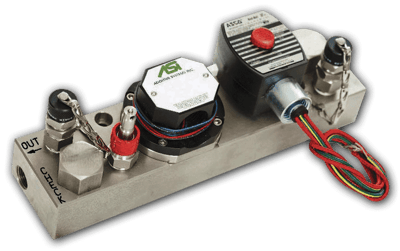Description
The ASI Hammer Injection Block manifold is a low cost solution to chemical additive injection in the petroleum terminal environment.
This manifold design meets all of the standard requirements for metering and control of a cyclical injection chemical stream.
The ASI Hammer Injection Block provides an electrically operated solenoid valve and a precision fluid meter in a common manifold.
In addition, the manifold includes inlet and outlet isolation valves, an inlet strainer, and an outlet check valve. Combining this functionality into a single monolithic manifold block reduces the size of the instrumentation.
This is critical in the limited space available on truck loading racks today.
Additionally, combining the solenoid, meter, and test port into a single manifold eliminates most potential leak points common to stick built manifolds assembled in the field.
This manifold block provides the physical instrument needed to allow a Terminal Automation System, Preset, or PLC System to directly control chemical additive injection.
This manifold does not include the electronics control necessary to pace the chemical to a flowing fuel stream, nor does it contain the logic necessary to accumulate additive volume passing through it.
AC line voltage is typically used to energize the solenoid valve and allow flow. The controlling device then accumulates flow volume in the form of pulses transmitted from the meter sensor.
When sufficient volume of additive chemical has moved through the manifold, the controlling device then turns off the solenoid valve in order to stop the flow.
It is the responsibility of the controlling device, Terminal Automation System, Preset, or PLC System, to perform the algorithms necessary to ratio the chemical properly into the fuel stream.
Functionality for recipe, injection interval, tolerance, alarm annunciation, shutdown, etc. are all the responsibility of the controlling system.
If the controlling system is not capable of this level of function, manifold blocks alone are not the solution.
Features- Stainless Steel Machined Manifold Block
- ⅜" FNPT Inlet & Outlet Connections Machined Into Block
- Oval Gear Meter Machined Into Manifold Block
- High Resolution Gears 5200 Pulses Per Gallon Output
- Meter Accuracy of 0.5%
- Meter Repeatability 0.25%
- Oval Gear Material Stainless Steel
- Gear Pinion Shafts of Carbide Tool Steel
- Explosion Proof Hall-Effect Meter Sensor
- Sensor is 3-wire Type with Power (12 VDC) and Common & Pulse Signal Connections
- ⅜" FNPT Calibration Port with Standard Quick Disconnect Coupler
- Built-In Strainer
- Built-In Check Valve
- Inlet & Outlet Isolation & Throttling Valves
- Solenoid 120 VAC
- Solenoid is UL or Cenelec Class I (Div I Machined into Manifold Block)
- 400 PSI Working Pressure
- 150 PSI Differential Pressure
- Solenoid is 303 SS Construction
- Solenoid Chemraz Seat Standard
Inventory
Displaying prices & availability for Ohio, United States in USD. Change location.
Models matching criteria: 4
Calibration Kit: Including Quick-Coupler (Female), Cylinder, Back Pressure Check Valve, and Spout
In Stock
New and Improved Calibration Port Quick-Coupler Male
In Stock
Inlet and Outlet Isolation/Flow Control Locking Needle Valves
In Stock
ASI Hammer Injection Block
In Stock
Specifications
Specifications
Brand
Certifications
- UL Listed Hazardous locations
- UL Listed 106A, CSA
- NEMA Type 3, 35, 4, 4X, 6, 6P, 7, & 9 Explosion-proof
Inlet/Outlet Size
- 3/8" Female NPT
Maximum Working Pressure
- 400 psi
Maximum Operating Pressure
- 150 psi Differential

